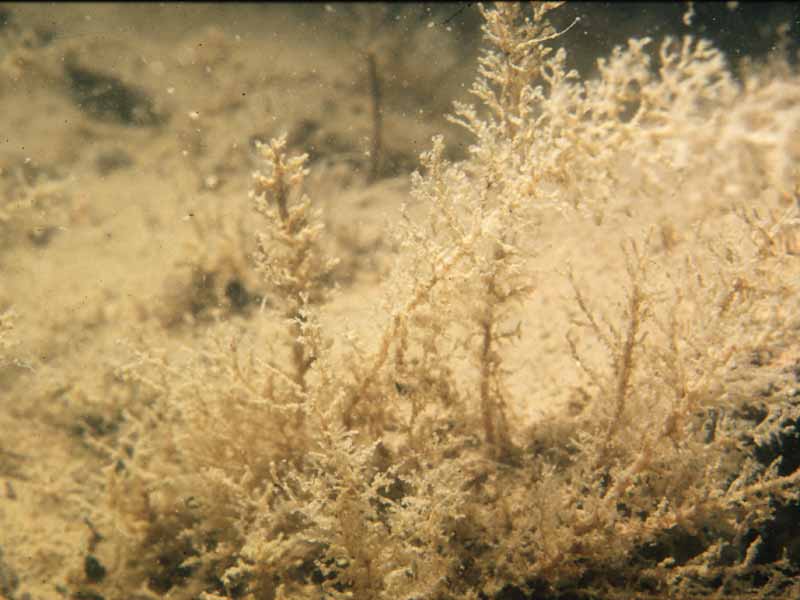A sea fir (Hartlaubella gelatinosa)
Distribution data supplied by the Ocean Biodiversity Information System (OBIS). To interrogate UK data visit the NBN Atlas.Map Help
| Researched by | Dr Harvey Tyler-Walters | Refereed by | Admin |
| Authority | (Pallas, 1766) | ||
| Other common names | - | Synonyms | - |
Summary
Description
Recorded distribution in Britain and Ireland
Reported from Poole Harbour and the Plymouth area in south England, Bangor, North Wales, Lough Foyle and Strangford Lough, Northern Ireland, and western Scotland. Probably under recorded.Global distribution
Reported from Oslo Fjord, Norway, south to Denmark, the Baltic Sea, the Mediterranean and the Black Sea. Also recorded on the west coast of the USA, Patagonia and New Zealand.Habitat
Small colonies found on the lower shore and in rock pools but larger colonies occurring in deeper water to ca 15 m, often in a gentle current. Tolerant of silt and brackish water down to at least 6.2 psu.Depth range
Lower shore to ca 15m.Identifying features
- Main stems rather thick;
- Branches straight, polysiphonic basally, monosiphonic and flexuose distally; with short branchlets at each flexure.
- Side branches bear ca 6 hydrothecae and typically 5-9 rings basally.
- Hydrothecae bell-shaped or cylindrical; rim castellate with 12-14 blunt cusps, often abraded smooth.
- Hydrothecae borne on pedicels of varied length, ringed throughout or with smooth central portions. Male and female gonothecae, inverted conical in shape and born at angle of branches.
- 4-6 embryos produced per gonotheca, which a brood to the planula stage.
Additional information
Reproduction thought to occur from May to August but may be extended from April to November (Cornelius, 1995b). This species may be confused with other Obeliinae e.g. Obelia bidentata, especially when young, however, the main stem of Hartlaubella gelatinosa is darker than its final branches and branching is alternate at right angles to the stem. The taxonomy of Hartlaubella is a matter of debate (see Stapanjants, 1998 for discussion).Listed by
Bibliography
Cornelius, P.F.S., 1995b. North-west European thecate hydroids and their medusae. Part 2. Sertulariidae to Campanulariidae. Shrewsbury: Field Studies Council. [Synopses of the British Fauna no. 50]
Gili, J-M. & Hughes, R.G., 1995. The ecology of marine benthic hydroids. Oceanography and Marine Biology: an Annual Review, 33, 351-426.
Hayward, P.J. & Ryland, J.S. (ed.) 1995b. Handbook of the marine fauna of North-West Europe. Oxford: Oxford University Press.
Hincks, T., 1868. A history of the British hydroid zoophytes, vol. I & II. London: van Voorst.
Howson, C.M. & Picton, B.E., 1997. The species directory of the marine fauna and flora of the British Isles and surrounding seas. Belfast: Ulster Museum. [Ulster Museum publication, no. 276.]
JNCC (Joint Nature Conservation Committee), 1999. Marine Environment Resource Mapping And Information Database (MERMAID): Marine Nature Conservation Review Survey Database. [on-line] http://www.jncc.gov.uk/mermaid
Picton, B.E. & Costello, M.J., 1998. BioMar biotope viewer: a guide to marine habitats, fauna and flora of Britain and Ireland. [CD-ROM] Environmental Sciences Unit, Trinity College, Dublin.
Stepanjants, S.D., 1998. Obelia (Cnidaria, Medusozoa, Hydrozoa): phenomenon, aspects of investigations, perspectives for utilization. Oceanography and Marine Biology: an Annual Review, 36, 179-215.
Datasets
Bristol Regional Environmental Records Centre, 2017. BRERC species records recorded over 15 years ago. Occurrence dataset: https://doi.org/10.15468/h1ln5p accessed via GBIF.org on 2018-09-25.
Bristol Regional Environmental Records Centre, 2017. BRERC species records within last 15 years. Occurrence dataset: https://doi.org/10.15468/vntgox accessed via GBIF.org on 2018-09-25.
NBN (National Biodiversity Network) Atlas. Available from: https://www.nbnatlas.org.
OBIS (Ocean Biodiversity Information System), 2025. Global map of species distribution using gridded data. Available from: Ocean Biogeographic Information System. www.iobis.org. Accessed: 2025-07-31
Citation
This review can be cited as:
Last Updated: 31/03/2002



